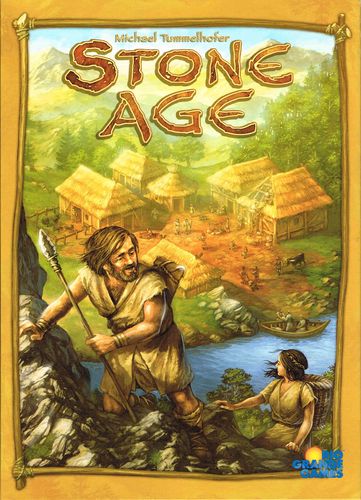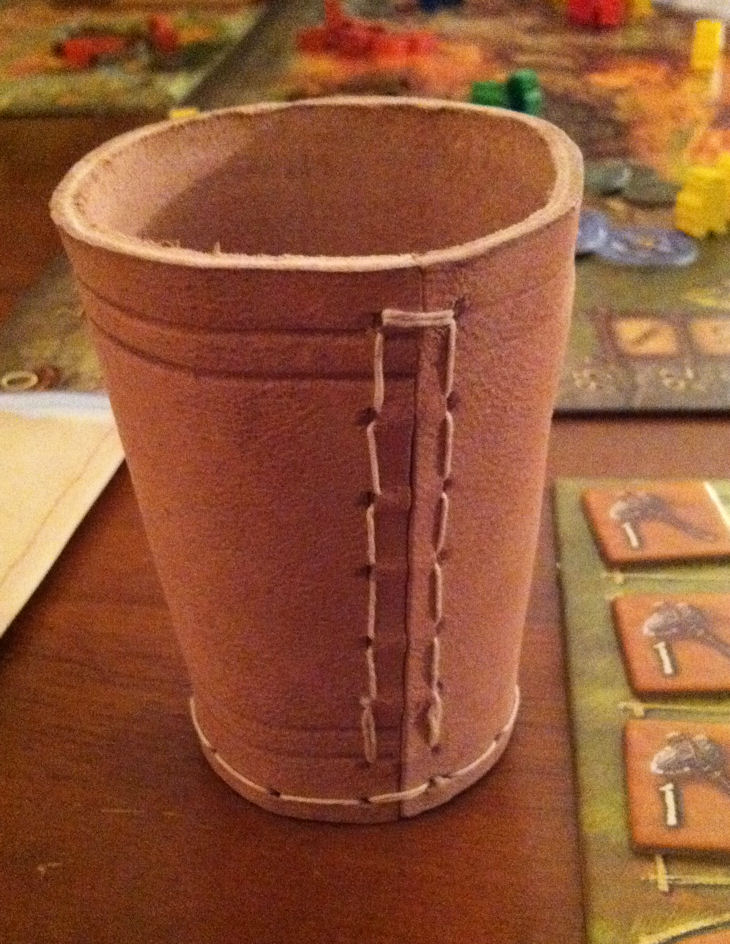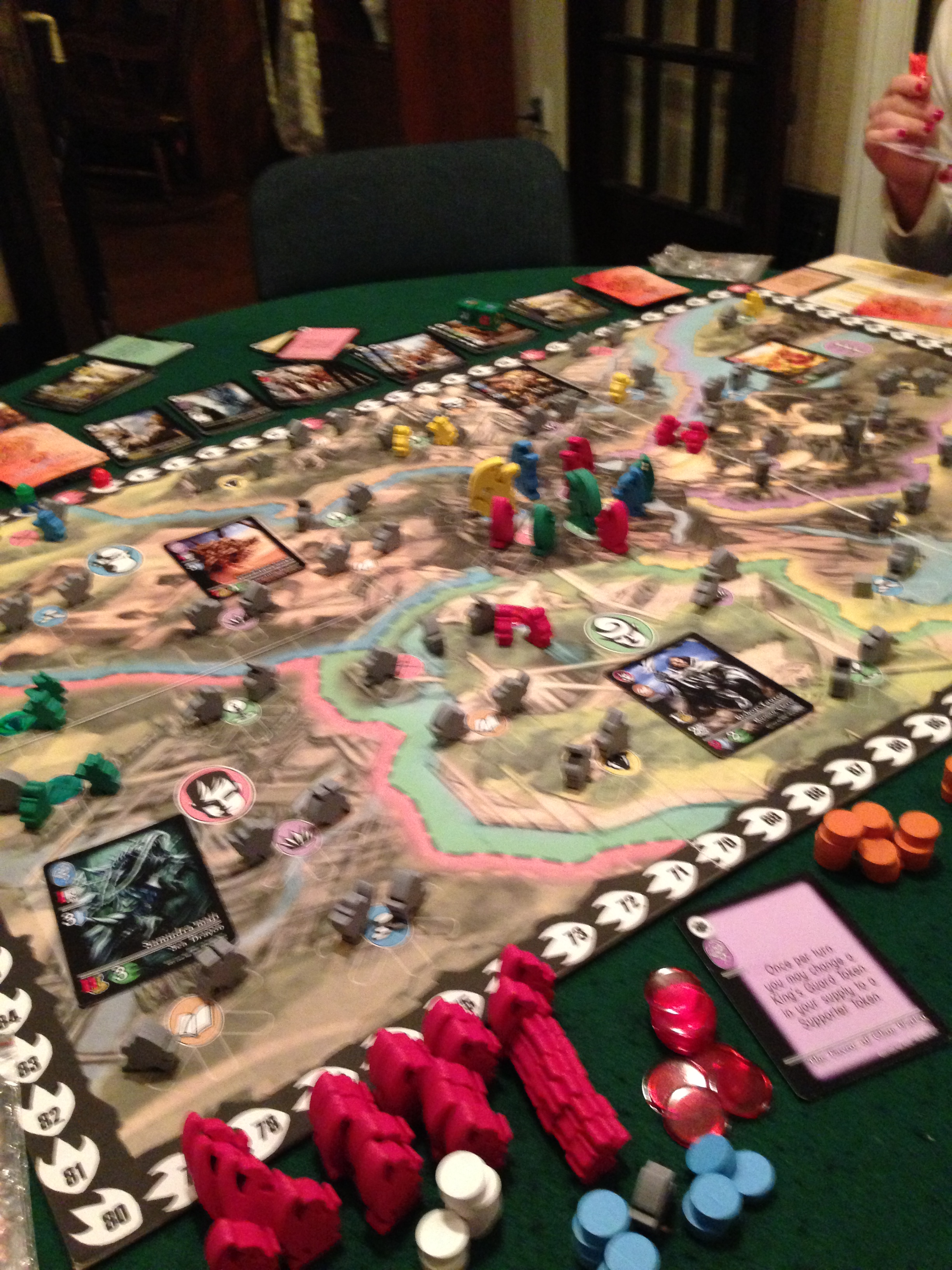 - By Jeremiah
Clever Mojo Games has, along with designer Fred MacKenzie, put together a large-scale board gaming experience that is truly unique...while somehow familiar.
- By Jeremiah
Clever Mojo Games has, along with designer Fred MacKenzie, put together a large-scale board gaming experience that is truly unique...while somehow familiar.
In Princes of the Dragon Throne players assume the role of one of the overlooked princes of the recently deceased Dragon King in the land of Lo'en. Beginning with a small amount of loyal followers you'll attempt to gather resources, persuade prospects to join your forces, and earn favor of the guilds throughout the kingdoms. Which prince among you and your siblings will rise to power and take the throne? Only time will tell.
The Components
The game comes with oodles of game bits, cards, and a huge game board. To be more specific there are:
216 custom miniatures
- 80 Supporters
- 60 Dragon Lords
- 4 Dragon Princes
- 72 King's Guards
179 Punchboard Chips
- 84 Guild and Score Markers
- 95 Resource Chips
157 Cards
- 36 Dragon Prospects
- 36 Citizen Prospects
- 40 Starter Deck cards (4 decks of 10)
- 36 Guild Favors
- 6 Clan Favors
- 2 Deck Title Cards
- 1 Bargain With the Giant card
4 Player Aid Sheets
2 Custom Sorcery Dice
1- 22" x 33" Game Board
And of course the Rule Book
There is no apparent sign of either a partridge or a pear tree.
Setup and Overview
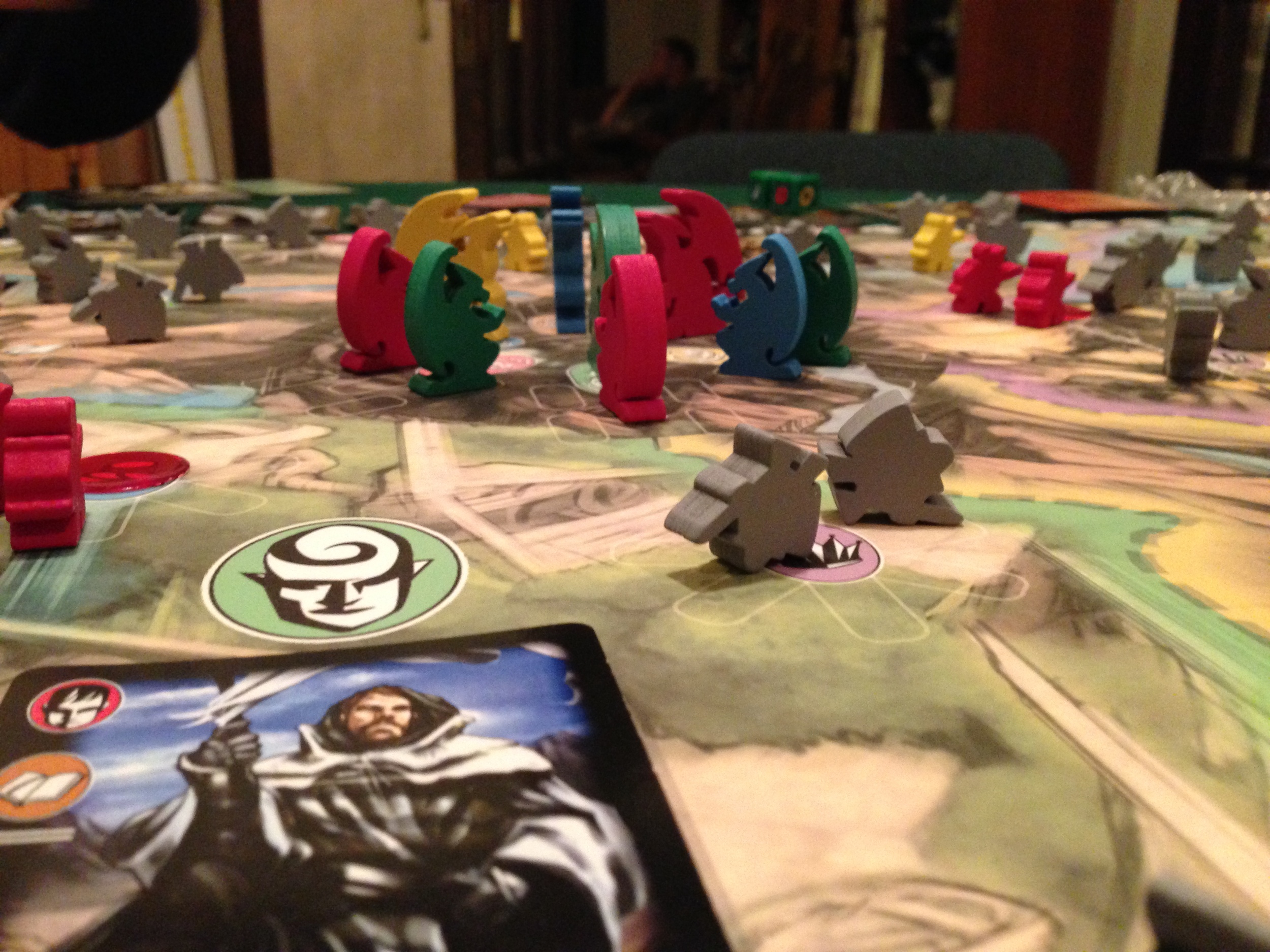 The board is separated into 6 kingdoms (Humans, Elves, Sorcerers, etc.); each kingdom is made up of 6 guilds (Merchants, Shepherds, Warriors, etc.). There is also a space for a prospect card (either dragon or citizen) in each kingdom. Surrounding each guild in every kingdom are 5 slots for Supporters or King's Guards.
To setup the game:
- Place 2 King's Guards in every guild (this will use all of them).
- Give each player their starting deck of 10 cards.
- Take 3 Dragon and 3 Citizen prospect cards, shuffle them, and place one in each kingdom.
- Give each player three of each resource type (Gold, Sheep and Influence).
- Each player then takes 5 of their Supporters (placing the rest to the side for now),all of their Dragon Lords, and their Dragon Prince.
The board is separated into 6 kingdoms (Humans, Elves, Sorcerers, etc.); each kingdom is made up of 6 guilds (Merchants, Shepherds, Warriors, etc.). There is also a space for a prospect card (either dragon or citizen) in each kingdom. Surrounding each guild in every kingdom are 5 slots for Supporters or King's Guards.
To setup the game:
- Place 2 King's Guards in every guild (this will use all of them).
- Give each player their starting deck of 10 cards.
- Take 3 Dragon and 3 Citizen prospect cards, shuffle them, and place one in each kingdom.
- Give each player three of each resource type (Gold, Sheep and Influence).
- Each player then takes 5 of their Supporters (placing the rest to the side for now),all of their Dragon Lords, and their Dragon Prince.
Players shuffle their starting deck, draw five cards, and the game begins.
There are lots of stacks of cards, and resources, and so forth, so the bigger the table the better!

Game Play
On a player's turn he or she can perform one of a possible four main actions, and a number of additional "King's Guard Actions," provided they have a King's Guard to use.
The four main actions are as follows:
Gather Resources—All the cards have two main functions, and gathering resources is one of those. On their turn players can play up to three cards from their hand and gather the amount of resources listed on them from the pool. If there are none left in the pool, you start pillaging them from other players, taking one at a time from each player moving counter-clockwise.
Recruit a Prospect—Once you've gathered enough resources, you can then begin to recruit prospects from the game board, by paying the value listed at the very bottom of the cards available. When you recruit that card, you snag another Supporter from your reserve pile; you also potentially score points (if there is a claw icon next to the cost). And if that wasn't enough, you get to remove a card from your hand or discard pile from the game!
Deploy Supporters—You can deploy up to 2 Supporters a turn, using two different cards from your hand. A Citizen card will give you two icons, which offers more flexibility; you can play a Supporter either in the matching Kingdom, on any guild, or on any matching guild in any Kingdom. Dragon supporters are locked into one Kingdom, on any guild, but they remove a King's Guard from the guild they are placed in (which goes into your reserve for later). Dragons also require you to feed them a number of sheep from your resources when you deploy them. You also can't deploy them where there are no King's Guards...
Maneuver Supporters—Finally if you choose to maneuver Supporters, you can move up to two of your Supporters from anywhere on the board to anywhere else on the board. This is great for taking over guilds, but also leaves guilds open for being taken over by other players... Speaking of taking over guilds...
If at any time you have more Supporters than any other player (or King's Guard) in a guild, you gain control of that guild. You get to place a spiffy token on it, score two points, and gain a guild favor card into your deck to use one time (and then it goes back into the general supply of guild favor cards). And you get to place one of your Dragon Lords into one of the houses around the Dragon Throne (either matching the color of the kingdom or guild that you just took control of).
After (or before) you've done one of those four main actions you can also use a King's Guard action (as many times as you like... provided you have a King's Guard to use).
The King's Guards that you gain by deploying Dragon Supporters allow you to do a few things.
- Place 2 new prospects (if you don't like any that are out there).
- Place 1 prospect card back on the top of a stack (if someone covered up one that you like).
- Discard any number of cards (you still don't get to draw back up until the end of your turn, but it gets you through your deck faster).
You may also play one, and only one, Guild Favor card during your turn.
When your turn is over, draw back up to five cards (if you've played any) and the next player begins their turn by placing new prospects from either the Dragon deck, or the Citizen deck (their choice) if there are any empty slots, and then they proceed to take their turn.
Parliament—One last feature of the game is Parliament. Whenever a player's scorekeeper passes a red spot on the score track (at 6, 13, 21 etc.) parliament is held and players take turns placing their Dragon Prince in a house (starting with the player in last place). Each house has its own house bonus, which will give the player a special edge, or action, on their turn. When the next number is reached you do it all again.
The Goal and Game End—The goal is simply to score more points than everyone else; the game ends when all the spots in the Houses around the Dragon Throne are filled.
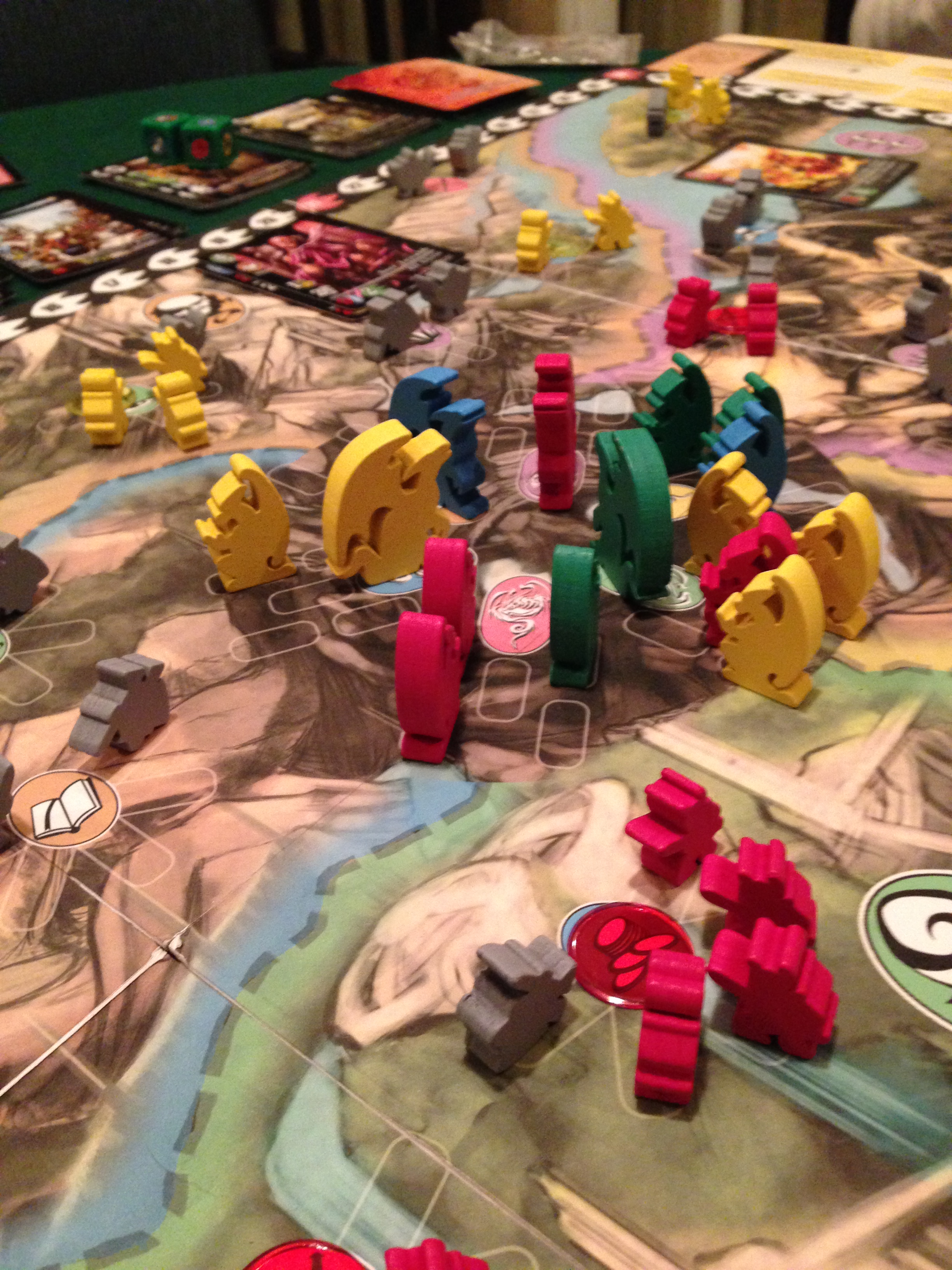 Thoughts and Recommendations -
Thoughts and Recommendations -
Family/Party Game? Uhmmm about that. No. The game isn't hard to learn, but there are tons of aspects to grasp before even beginning to strategize. This one is not for the kids.
Youth Group Game? Not really. The setup is lengthy, the gameplay is lengthier (about 2 hours, once you've learned the game), and it doesn't lend itself to a big group setting.
Gamer's Game? Absolutely! This may be the very definition of a Gamer's Game! Intricately woven mechanics, rich back-story, and tons of pieces-parts—the more I learned about the game the more I loved it!
Components—I can't really speak to the final quality of the components; I was sent a prototype of the game with good ol' fashioned wooden meeples. But I will say this: Even the "rough draft" style of the meeples was pretty fantastic, and the renderings of the finished minis look splendid! Clever Mojo is going all out for this one, folks!
Gameplay—There's a lot to take in. I've played with 2 players and with 4 players, and if you're in a 4-player game it can get a little sluggish if folks don't plan ahead. That being said, there are a ton of different decisions to make on each turn; just choosing which of the four main actions you're going to take can be a painstaking process! "Do I buy up that card before someone else does, or do I deploy Supporters while I've got this dragon in my hand, or do I save up resources so I can get that awesome dragon??" There's a ton of planning and a ton of decisions to make on each turn, so be ready to make threats of bodily harm to those who are lagging behind.
If I had any small complaint about the way the game plays, I'd have to say I don't know how well I like the Maneuver Supporters action. It seemed a little too free, with being able to (in a Risk-like fashion) move your Supporters around and conquer guilds. Yes, there was a risk (pun intended) to getting that reward, but I felt it could have used a little tweaking.
Artwork—Again, what I had my hands on was a prototype, and I don't know how close to final everything was. But the cards already looked fantastic—lots of great detailed illustrations, and not one was like the other. Each Dragon and Citizen featured a name and a bit of flavor text; a lot of work went into the thematic realm the game is placed in. Beautifully done.
Overall—With elements of deck-building, worker-placement, and area-control—and finding a great balance and synergy between the three, while throwing in a pinch of resource management—Princes of the Dragon Throne combines the best of your favorite game genres into a large-scale board game. Simply put: It's epic!
We'd like to thank Clever Mojo Games and Game Salute for loaning Jeremiah a prototype of the game; this had no effect on the content of this review.
If you'd like to back Princes of the Dragon Throne on Kickstarter, you can do so here.
Have you backed it already? Let us know!
We get ever-so-excited when folks sign up to get our posts via email, right over there, on the right!
Also you can find all kinds of Theology of Games goodness on Facebook, Twitter and Instagram! Check back soon as we interview Fred Mackenzie and his brother David Mackenzie, the brains behind Clever Mojo, Game Salute, and Princes of the Dragon Throne! Coming tomorrow! (June 5, 2013!)
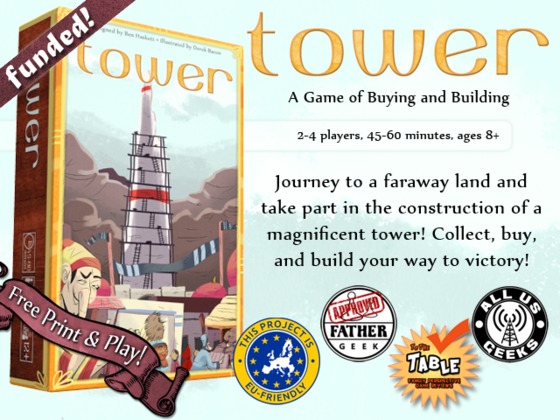 Tower: A Board Game of Bullying and Building - Ben Haskett
Tower: A Board Game of Bullying and Building - Ben Haskett Shipwrights of the North Sea - Shem Phillips/Garphill Games
Shipwrights of the North Sea - Shem Phillips/Garphill Games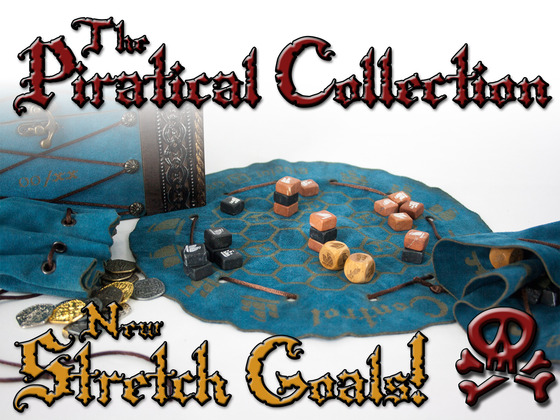 The Piratical Collection of Leather Pouch Games - Bibelot Games
The Piratical Collection of Leather Pouch Games - Bibelot Games






